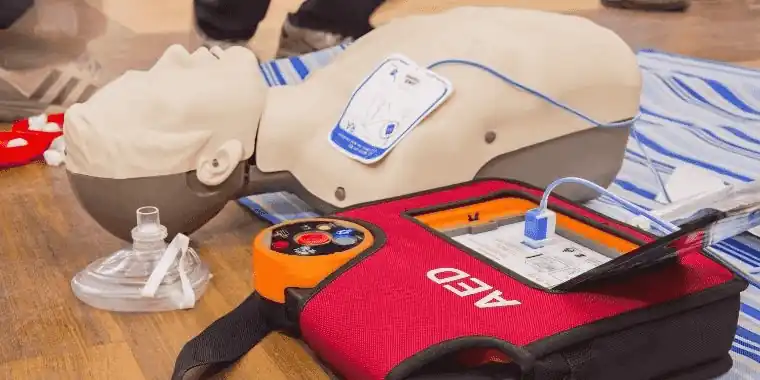Defibrillators – How to use a defibrillator safely – The Training Hub
Defibrillators are an important piece of medical equipment. Designed to restart a failing heart, they are capable of saving lives when used properly. This article explains how to safely use a defibrillator and gives information about them.
How does a Defibrillator Work?
Defibrillators are often referred to as Automated External Defibrillation devices (AED). They come in a range of shapes and sizes but all focus on attempting to restart a patient’s failing heart.
A defibrillator works by sending a high-energy electric shock through the heart, which restarts it in the event of a cardiac arrest. The sticky pads on the defibrillator need to be in contact with the bare skin of the patient being aided. This allows the defibrillator to measure the person’s heart rate, and by doing so determine if being given a shock from the defibrillator will actually help them or not. The defibrillator will then sound a notification to apply a shock. It will then sound again so you know when to stop applying CPR so that it can begin analysing the heart rhythm again.

How to use Defibrillators:
As defibrillators are used when someone is suffering from a suspected cardiac arrest (if they are unconscious, not breathing, breathing incorrectly, or are unresponsive, there is a good chance this is the case), the most important thing is to immediately call 999 and begin performing CPR, since every minute gone by without CPR being administered reduces the chances of survival by 10%.
While a defibrillator can be very useful, you must not stop administering CPR to try and find one; your 999 operators will be able to tell you if there is a public access defibrillator nearby and, unless they instruct you to do so, you should send someone else to fetch it for you.
If you do have access to a defibrillator, using one is a relatively simple process. Defibrillators typically have spoken instructions that will be given once you turn it on, and more often than not they also have printed instructions in the form of diagrams to help guide you through each of the steps in the process.
At TutorCare training we offer certification through our Automated External Defibrillation (AED) training course. The course explains how to respond to conscious/unconscious heart attacks, demonstrates the use of CPR and teaches the applicant how to identify situations where AED does/doesn’t apply. You’ll also be shown how to operate the most common types of AED safely through a combination of practical and theory-based sessions.

Typically, using a defibrillator is as simple as following a 6 step process:
- Power up the defibrillator by pressing the green button; follow any instructions the defibrillator gives you.
- Peel off the sticky pads from the defibrillator, and apply them to the patient’s chest in accordance with the diagrams you are shown. The pads should be applied with one on each side.
- After applying the pads, cease CPR and refrain from touching the subject; at this point, the defibrillator will begin analysing the heart rhythm of the patient.
- The defibrillator will then inform you if applying a shock will aid the patient. It will tell you to press the shock button, or, if it is an automatic defibrillator, will do so without requiring human input. You must not touch the patient whilst the shock is being delivered.
- The defibrillator will tell you once the shock has been delivered, and whether or not you should resume administering CPR.
- If it was required, you should continue with the chest compressions and rescue breaths. If they start showing signs of life, then the situation has de-escalated. Alternatively, the defibrillator may tell you to cease so that it can analyse the heart rhythm of the patient another time, to see if another shock will help. If it is, keep repeating the process until signs of life are shown, or first responders arrive.
TutorCare offers an AED training course.
heartsafe.org.uk offer a list of Public Access Defibrillators around the country. Please note that there are no legal obligations for owners of defibrillators to register their devices with the Ambulance Service but this list can be vital should you ever need access to one.



